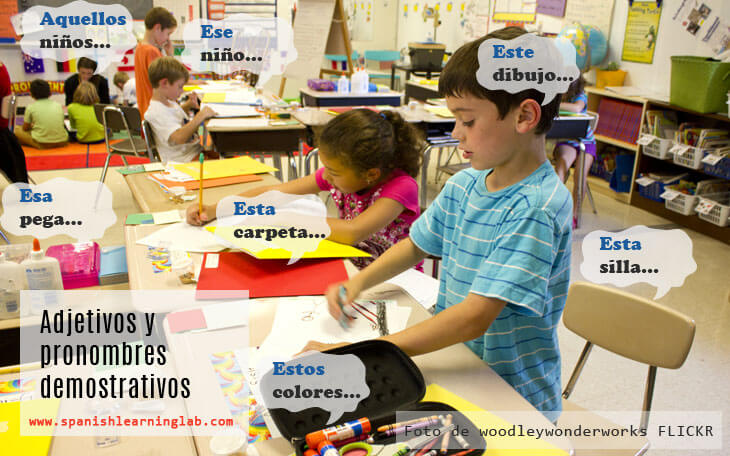Spanish demonstrative adjectives and demonstrative pronouns, “los demostrativos”, are words like ESE, ESTE, ESE and others which correspond to THIS, THAT and so on in English. In this lesson, we will cover some similarities in the way we use demonstratives in both languages, and some major differences you should know about. Let’s begin…
What are demonstratives in Spanish?
Both demonstrative adjectives and demonstrative pronouns are actually represented by the same words in the language, which means that the word “ESTE” is both a type of pronoun and an adjective, but still, there are some differences in the way we use them. The main difference is the function that they play when used in sentences. Spanish demonstrative adjectives will be used directly before a noun, whereas Spanish demonstrative pronouns will play either the role of the subject or the object in a sentence.

The demonstrative to use will vary according to the gender (masculine/feminine) and number(singular/plural) of the noun we are referring to. The chart below shows a list of demonstratives in Spanish, plus their corresponding meaning in English.
Spanish demonstratives chart
| Demonstrative in Spanish | Meaning |
|---|---|
| Ese, aquel (masculine/singular) | That |
| Esos, aquellos (masculine/plural) | Those |
| Esa (feminine/singular) | That |
| Esas, aquellas (feminine/plural) | Those |
| Este (masculine/singular) | This |
| Estos (masculine/plural) | These |
| Esta (feminine/singular) | This |
| Estas (feminine/plural) | These |
How to use Spanish demonstrative adjectives in sentences
First, Spanish demonstrative adjectives are always placed before the noun they modify. If the noun is masculine and singular, like the word “auto” (car), then we must use a demonstrative in masculine, singular form, such as: “ESTE”(this), “ESE”(that) and “AQUEL”(that). By applying this rule to the noun “auto”, we can easily say “Este auto” (this car), “Ese auto”(that car) and “Aquel auto” (that car). The demonstrative “Aquel” is often used for more distant objects. Following the same rules, for feminine, plural nouns such as “rosas”, we would say “estas rosas”, “esas rosas” and “aquellas rosas”. Listen to some more examples with these words below.
Sentences using Spanish demonstrative adjectives
|
Este auto es nuevo.
This car is new
|
|
Estos autos son nuevos.
These cars are new
|
|
Esa niña es alta.
That girl is tall
|
|
Esta casa es grande.
This house is big
|
|
Estas casas son grandes.
These houses are big
|
|
Esos niños son inteligentes.
These kids are intelligent.
|
|
Aquellos niños están jugando fútbol.
These kids are playing soccer
|
Interactive quiz No. 1
Listen to the following recording using demonstratives with some Spanish nouns. Then, drag these words and drop them into the correct boxes.
How to use Spanish demonstrative pronouns in sentences
Spanish demonstrative pronouns are the same words as demonstrative adjectives, but they can only work as the subject or the object of the sentence. Take a look at these two sentences:
- “Este es mi libro” (this is my book)
- “Ese es tuyo” (that one is yours.)
Here, the demonstrative pronouns “ESTE” and “ESE” work as the subject of the sentences. You can easily know that by looking at two interesting features; first, ESTE and ESE were not used directly before a noun and second they precede a verb, the verb SER (Es ese/ Son esos…).
When Spanish demonstrative pronouns are used as objects in sentences, they are placed after a verb, not at the beginning of the sentence, for example:
- “Mi libro es ese” (my book is that one).
- “Mis amigos son aquellos de allá.” (My friends are those over there.)
In the previous examples, the words “ese” and “aquellos” are demonstrative pronouns working as objects in the sentences. In addition, we can even reverse this sentence with the demonstrative as the subject, and it will make sense anyway, e.g. “Ese es mi libro.” Listen to some examples of sentences with these pronouns as the subject of the sentences, and try to revert them yourself to make the pronoun the object instead.
Sentences using Spanish demonstrative pronouns
|
Este es mi perro y ese es mi gato.
This is my dog and that is my cat.
|
|
Los pasteles están en la mesa. Estos tienen jalea y esos tienen carne.
The cakes are on the table. These have jelly and those have meat.
|
|
Estas fotos son de mi viaje a Japón y aquellas son del viaje a China.
These pictures are from my trip to Japan and those are from the trip to China
|
|
De esos jugadores, ese juega fútbol y aquel juega beisbol.
From those players, that plays soccer and that one plays baseball.
|
Interactive quiz No. 2
Read this short paragraph and mark the words representing demonstrative pronouns in Spanish
Interactive quiz No. 3
Related PDF Worksheets:
- Demonstrative Adjectives in Spanish (Chart + Sentences)
- Demonstrative Pronouns in Spanish (Sentences)
- Classroom Items in Spanish (Words + Sentences)
